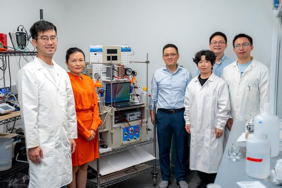Home > Press > Rice membrane extracts lithium from brines with greater speed, less waste
 |
| Qilin Li (second from left) and Jun Lou (third from left) are co-corresponding authors on a study published in Nature Communications.
Credit Photo by Jorge Vidal/Rice University |
Abstract:
A team of researchers at Rice University has developed a new membrane that selectively filters out lithium from brines, offering a faster, cleaner way to produce the element at the heart of nearly every rechargeable battery.
Rice membrane extracts lithium from brines with greater speed, less waste
Houston, TX | Posted on October 3rd, 2025
According to a study published in Nature Communications, the new membrane achieved one of the highest selectivities for lithium among similar membranes while using considerably less energy. The membrane design can be adapted to target the recovery of other valuable minerals, such as cobalt and nickel, and plugs into existing industrial setups. Tests of the materials performance and durability indicate it is prime for large-scale synthesis.
Most of the worlds lithium is extracted from saltwater deposits, or brines, which involves sprawling evaporation ponds and extensive chemical treatments. The process is slow, inefficient and environmentally costly.
The most widely used large-scale lithium extraction method today requires massive evaporation ponds and chemical precipitation, said Qilin Li, the Karl F. Hasselman Professor of Civil and Environmental Engineering and co-director of Rices Nanotechnology Enabled Water Treatment (NEWT) Center. The process can take over a year to reach the target concentration and has fairly low lithium recovery rates. It also uses a lot of water, often in places that already experience water scarcity, and produces considerable amounts of chemical waste.
The new membrane offers an alternative way of extracting the lithium via electrodialysis: When an electrical current is applied, lithium ions pass through the membrane, while far more abundant elements like sodium, calcium and magnesium remain behind.
Typically when you apply an electrical field, all the positively charged ions will transport across the cation exchange membrane, Li said. Lithium is actually a minor component in brine, but our membrane allows primarily lithium to transport across. Other ions stay behind.
That selectivity makes the process both more efficient and less energy-intensive than standard industrial electrodialysis, which is typically used for desalination and wastewater treatment. The team achieved this by embedding nanoparticles of lithium titanium oxide (LTO) into the membrane, taking advantage of LTOs crystal structure, which is just the right size for lithium ions to move through.
The challenge in utilizing LTO or other lithium ion sieves in membranes is the poor compatibility of the inorganic ion sieves with the polymeric membrane matrix, which often leads to defects in the membranes, undermining performance. To overcome this limitation, the Rice team grafted the LTO with amine groups, which made it possible to mix them evenly into a plasticlike layer called polyamide, creating a strong, defect-free skin for the membrane.
This project builds on our work through the NEWT Center, so it draws on 10 years of research on nanomaterials and nanotechnology, said Li, who is one of the leaders of the Rice WaTER (Water Technologies Entrepreneurship and Research) Institute. We have learned how to incorporate nanomaterials into membranes and how to make nanocomposite membranes that fulfill a desired set of functions.
Each of the membranes three layers can be independently optimized, making it a good platform for other applications such as the selective extraction of cobalt or nickel.
Our goal was to develop a material that can extract lithium with minimum environmental impact, Li said. The smart design principles we used to develop the membrane architecture have ensured it can be adapted to help recover many other valuable resources from various waste streams.
One of the important features of our membranes is their potential to be produced at scale, which could pave the way for their use in industrial settings, said Jun Lou, the Karl F. Hasselmann Professor of Materials Science and Nanoengineering.
The researchers tested the new membrane in an electrodialysis system and used computer simulations to zoom in and see how it works at the atomic level. The membrane proved strong and durable, maintaining its performance and withstanding degradation even after two weeks use.
Major contributors on the study included Rice alumni Yuren Feng and Xiaochuan Huang as well as Yifan Zhu, a postdoctoral researcher in the Lou lab.
The research was supported by the National Science Foundation (1449500, 1338099), the U.S. Department of Interior (R23AC00442) and the Center for Research Computing at Rice.
####
About Rice University
Located on a 300-acre forested campus in Houston, Texas, Rice University is consistently ranked among the nations top 20 universities by U.S. News & World Report. Rice has highly respected schools of architecture, business, continuing studies, engineering and computing, humanities, music, natural sciences and social sciences and is home to the Baker Institute for Public Policy. Internationally, the university maintains the Rice Global Paris Center, a hub for innovative collaboration, research and inspired teaching located in the heart of Paris. With 4,776 undergraduates and 4,104 graduate students, Rices undergraduate student-to-faculty ratio is just under 6-to-1. Its residential college system builds close-knit communities and lifelong friendships, just one reason why Rice is ranked No. 1 for lots of race/class interaction and No. 7 for best-run colleges by the Princeton Review. Rice is also rated as a best value among private universities by the Wall Street Journal and is included on Forbes exclusive list of New Ivies.
For more information, please click here
Contacts:
Silvia Cernea Clark
Rice University
Office: 7133486728
Copyright © Rice University
If you have a comment, please Contact us.
Issuers of news releases, not 7th Wave, Inc. or Nanotechnology Now, are solely responsible for the accuracy of the content.
News and information
![]()
Researchers develop molecular qubits that communicate at telecom frequencies October 3rd, 2025
![]()
Next-generation quantum communication October 3rd, 2025
![]()
“Nanoreactor” cage uses visible light for catalytic and ultra-selective cross-cycloadditions October 3rd, 2025
Mining/Extraction/Drilling
![]()
Chile coating and composite industry makes leap forward leveraging graphene nanotube solutions April 9th, 2021
![]()
Membrane technology could cut emissions and energy use in oil refining July 17th, 2020
![]()
Extraction of lithium from its largest source, i.e. seawater, by nanostructured membranes January 27th, 2020
Possible Futures
![]()
Spinel-type sulfide semiconductors to operate the next-generation LEDs and solar cells For solar-cell absorbers and green-LED source October 3rd, 2025
Announcements
![]()
Researchers develop molecular qubits that communicate at telecom frequencies October 3rd, 2025
![]()
Next-generation quantum communication October 3rd, 2025
![]()
“Nanoreactor” cage uses visible light for catalytic and ultra-selective cross-cycloadditions October 3rd, 2025
![]()
Researchers tackle the memory bottleneck stalling quantum computing October 3rd, 2025
Interviews/Book Reviews/Essays/Reports/Podcasts/Journals/White papers/Posters
![]()
Spinel-type sulfide semiconductors to operate the next-generation LEDs and solar cells For solar-cell absorbers and green-LED source October 3rd, 2025
![]()
Researchers develop molecular qubits that communicate at telecom frequencies October 3rd, 2025
Battery Technology/Capacitors/Generators/Piezoelectrics/Thermoelectrics/Energy storage
![]()
Sensors innovations for smart lithium-based batteries: advancements, opportunities, and potential challenges August 8th, 2025
![]()
Deciphering local microstrain-induced optimization of asymmetric Fe single atomic sites for efficient oxygen reduction August 8th, 2025
![]()
Simple algorithm paired with standard imaging tool could predict failure in lithium metal batteries August 8th, 2025










